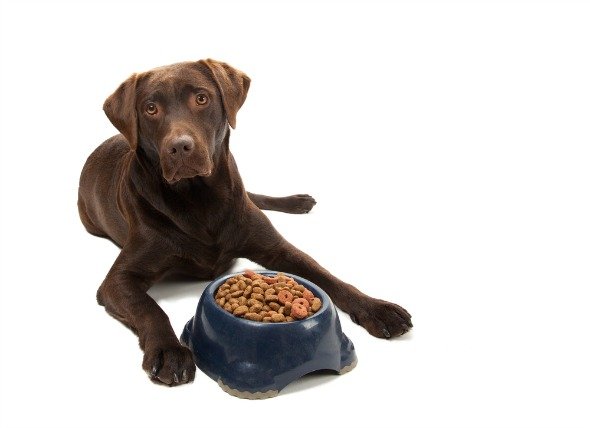
Whole grain corn, poultry by-product meal, corn gluten meal, animal fat preserved with mixed-tocopherols (form of Vitamin E), meat and bone meal, brewers rice, soybean meal, whole grain wheat, egg and chicken flavor, animal digest, salt, calcium carbonate, potassium chloride, calcium phosphate, L-Lysine monohydrochloride, choline chloride, zinc sulfate, added color (Yellow 6, Yellow 5, Red 40, Blue 2), DL-Methionine, Vitamin E supplement, zinc proteinate, ferrous sulfate, manganese sulfate, manganese proteinate, niacin, Vitamin A supplement, brewers dried yeast, copper sulfate, calcium pantothenate, copper proteinate, garlic oil, pyridoxine hydrochloride, Vitamin B-12 supplement, thiamine mononitrate, Vitamin D-3 supplement, riboflavin supplement, calcium iodate, menadione sodium bisulfite complex (source of Vitamin K activity), folic acid, biotin, sodium selenite.
Sounds simple enough. Back home, we read the back of the shampoo bottle and find ourselves as baffled by the names of the chemicals used as if they were written in Japanese. That doesn’t mean whatever you’re using is 100% safe. But imagine ingesting it. Imagine giving your loving pooch food that the FDA categorizes as inedible for humans. Simple words take another meaning, and we’re going to show you a glimpse of what we’re talking about:
1) Poultry by-product meal: ground up carcass of slaughtered poultry. May include: feet, neck, intestines, bones, blood, lungs, etc. – basically whatever humans don’t eat. Animal could have been sick prior to being killed.
2) Corn gluten meal: Cheap filler and protein. What’s left after removing starch and germ and after separating the bran.
3) Soybean meal: AAFCO defines it as “the product obtained by grinding the flakes which remain after removal of most of the oil from soybeans by a solvent or mechanical extraction process.”
4) Yellow 6, Yellow 5, Red 40, Blue 2: Some studies show these chemicals carry health risks such as cancer and allergic reactions.
5) Animal fat preserved with mixed-tocopherols (form of Vitamin E): What you just read, but with preservatives. It comes from rendered animal fat or oils considered too unhealthy or rancid for human consumption. Usually added to make dried up kibbles tastier.
6) Meat and bone meal: Cheap sources of protein. If the food contains excessive amounts of bone, it may not be digested properly, thus providing little to no nutrients.
7) Egg and chicken flavor: Yeah- flavor. The Dog Food Project website defines it as “a substance, such as an extract or spice, that add flavor to a product.”
8 ) Animal digest: According to AAFCO – “material which results from chemical and/or enzymatic hydrolysis of clean and un-decomposed animal tissue. The animal tissues used shall be exclusive of hair, horns, teeth, hooves and feathers, except in such trace amounts as might occur unavoidably in good factory practice and shall be suitable for animal feed.”
9) Preservatives to avoid: Butylated Hydroxysanisole (BHA), Butylated Hydroxytoluene (BHT), Ethoxyquin, and Propyl Gallate. Ethoxyquin should be tagged with a blaring warning.
10) Brewers Rice: According to AAFCO, “The small milled fragments of rice kernels that have been separated from the larger kernels of milled rice.” In other words, cheap carbs.
11) Menadione Sodium Bisulfate: Synthetic form of Vitamin K. Hasn’t been approved for long-term use and might lead to serious health issues.
The companies providing your household with these questionable ingredients are thinking cheap. They want affordable sources of protein, fillers (such as rice and corn meal), and fiber that are usually too yucky for consumption, thus the use of fat, salt, sugar, and other additives or substances to lure your pet to eat what you, as an individual, would throw out in distaste. Who eats hooves anyway? Apparently, your dog or cat!We just showed you an oversimplified glimpse of the pet food controversy. It is your duty, as a responsible human, to find out more.
One of CAPS friends, Susan Thixton, has dedicated herself to raising awareness about the issue at hand. When Thixton found out her beloved 8-year-old Rottweiler, Sam, had died of bone cancer due to preservatives such as Ethoxyquin found in the food she bought, she knew someone had to do something about it. In 2006, she created a website to uncover the horrors behind the pet food industry and the health-risks many products pose to companion animals. A pet owner and animal lover, Thixton writes articles, reviews, and provides information to people like us who want to provide the best of the best to our loved ones. Please check out truthaboutpetfood.org for more information.
Still thinking about buying the $4.99 bag of tasty chicken by-product? We hope not!




